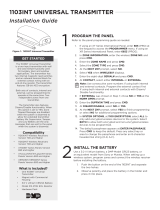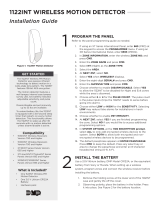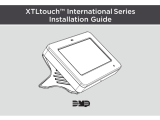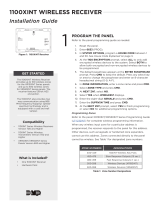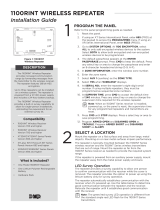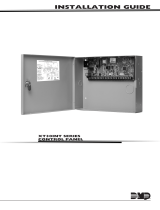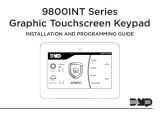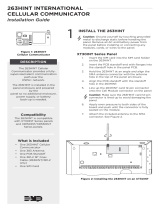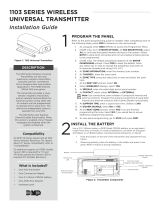Page is loading ...

1100DINT WIRELESS RECEIVERS
Installation Guide
GET STARTED
RF RX
RF TX
PANEL RX
PANEL TX
WALL
TAMPER
ENABLE
DISABLE
STATUS
PWR
The 1100DINT Wireless Receiver
provides up to 32 wireless
zones for XT30INT Series
panels.
The 1100DINT Series features
128‑bit AES encryption and
provides two‑way, supervised
communication using 868 MHz
frequency‑hopping‑spread‑
spectrum technology.
The receiver is equipped with a
case and wall tamper.
Compatibility
• 1100INT Series Wireless
Receivers Version 700 and
Higher
• 1100INT Series Wireless
Transmitters Version 700 and
Higher
• XT30INT Series Panels
Version 693 and Higher
• XTLtouchINT/XTLplusINT
Series Panels Version 693 and
Higher
What is Included?
• One 1100DINT Wireless
Receiver
• Hardware pack
1PROGRAM THE PANEL
Refer to the panel programming guide as needed.
1. Reset the panel.
2. Enter 665 (PRO) at the keypad to access the PROGRAMMER
menu.
3. In SYSTEM OPTIONS, program a HOUSE CODE between 1
and 50. See House Code Explained on page 3.
4. Select NO at the BUILT IN 1100 WIRELESS prompt to allow
the panel to use the 1100DINT for wireless communication.
5. At the 1100 ENCRYPTION prompt, select ALL to only add
encrypted wireless devices to the system. Select BOTH to
allow both encrypted and non‑encrypted wireless devices to
be programmed.
6. The default passphrase appears at the ENTER PASSPHRASE
prompt. Press CMD to keep the default. Press any select key
or area to change the passphrase and enter an 8‑character
hexadecimal string (0‑9, A‑F).
7. Press CMD until STOP displays. Press a top row select key or
area to save and exit programming.
Programming Zones
Refer to the panel XT30INT Series Programming Guide
(LT‑0981INT) for complete wireless programming information.
When any wireless input zone for a particular address is
programmed, the 1100DINT responds to the panel for this address.
Other devices, such as keypads or hardwired zone expanders,
cannot use this address. Zones connected directly to the panel
cannot be wireless. See Table 1 for designated zone numbers.
KEYPAD ADDRESS ZONE NUMBERS
1 11‑14
2 21‑24
3 31‑34
4 41‑44
5 51‑54
6 61‑64
771‑74
8 81‑84
Table 1: Zone Number Designations
Figure 1: 1100DINT Receiver

2 1100DINT INSTALLATION GUIDE | DIGITAL MONITORING PRODUCTS
MOUNT THE 1100DINT RECEIVER
The receiver is equipped with a case and wall tamper. When the housing cover is removed, the case tamper
activates and the receiver sends a tamper trouble to the panel. To enable the tamper, see the following steps.
A two‑position header is provided to disable the wall tamper. To disable the wall tamper, place the jumper
across the two pins of the header.
1. With the cover already removed, remove the PCB from the housing to access the tamper and mounting
holes.
2. Mount the receiver on a flat surface using the supplied screws. See Figure 2 for mounting hole locations.
3. Use one of the provided screws to anchor the housing in the wall tamper screw hole.
4. Snap the PCB back into the housing attached to the wall. Observe LED operation.
3
2The receiver should be centrally located between the DMP panel and the 1100INT Series transmitters used
in the installation. The receiver can be extended up to 500 ft from the panel using 22 AWG or 1,000 ft using
18 AWG. Mount the receiver away from large metal objects. Do not use shielded wire between the panel and
receiver.
LED Survey Operation for 1100INT Series Transmitters
1100INT Series transmitters provide a survey operation that allows one person to confirm communication with
the wireless receiver or panel while the cover is removed. Follow the directions below to test communication of
the wireless transmitters.
1. With the cover removed, hold the transmitter in the exact desired location.
2. Press the tamper switch to send data to the wireless panel and determine if communication is confirmed
or faulty.
Confirmed: If communication is confirmed, for each press or release of the tamper switch, the LED
blinks immediately on and immediately o.
Faulty: If communication is faulty, the LED remains on for several seconds or flashes multiple times
in quick succession. Relocate the transmitter or the wireless receiver until the LED confirms clear
communication.
SELECT A LOCATION
Tamper Puck
Mounting Hole
Battery
Figure 2: Inside of the 1100DINT Housing

1100DINT INSTALLATION GUIDE | DIGITAL MONITORING PRODUCTS 3
4WIRE THE 1100DINT RECEIVER
1. Connect the red, yellow, green, and black wires to the PANEL terminal on the 1100DINT. Connect the
other end of the wires to the 7, 8, 9, and 10 terminals on the panel. See Figure 3.
2. Replace the cover back on to the base. The panel immediately recognizes the receiver if the panel is
programmed with a house code.
ADDITIONAL INFORMATION
1100DINT LED Operation
The six labeled LEDs on the 1100DINT PCB display wireless receiver operation and activity. See Figure 3 for LED
locations and Table 2 for LED indications.
Note: The status LED light will remain solid red when wireless jamming is enabled or if there is a large amount of
RF activity in the vicinity of the receiver.
House Code Explained
The house code identifies the panel, receiver, and transmitters to each other. The 1100DINT automatically sends the
specified house code to wireless transmitters when transmitter serial numbers are programmed into the panel. The
1100DINT only listens for transmissions using the specified house code or the programmed transmitters’ serial numbers.
Black
Green
Yellow
Red
J4
RED PRO
J8
XT30INT
Series Panel
J7
RJ SUP
AC
1234 5 6 7 810 11 12
9
+B BELL GND SMK
RED YEL GRN BLK
AC -B
Can be extended
up to 500 ft
from the panel
using 22 AWG
or 1,000 ft
using 18 AWG
1100DINT
Receiver
LED INDICATIONS
RF RX Flashes yellow to indicate data is being received from a transmitter.
RF TX Flashes green to indicate data is being sent to a transmitter.
PANEL RX Flashes yellow to indicate data is being received from a panel.
PANEL TX Flashes green to indicate data is being sent to the panel.
STATUS Solid red to indicate memory is being uploaded. Turns o when complete.
PWR Solid green to indicate there is power to the wireless receiver.
Table 2: 1100DINT LED Indications
Figure 3: Wiring the 1100DINT to the Panel

Designed, engineered, and
manufactured in Springfield, MO
using U.S. and global components.
LT-1820INT 1.01 22133
PRODUCT NUMBER
INTRUSION • FIRE • ACCESS • NETWORKS
2500 North Partnership Boulevard
Springfield, Missouri 65803-8877
800.641.4282 | DMP.com
Part Graphic
© 2022
1100DINT WIRELESS
RECEIVERS
Specifications
Security Grade 2 Type B ACE
Environmental Class II
Operating Temperature 0°C - 49°C
32°F - 120°F
Relative Humidity 80%
Weight .23kg
Operating Voltage 8.0 to 14.0 VDC
Current Draw 25mA (average), 35mA (peak)
Frequency Range 863-869 MHz
Housing Material Flame retardant ABS
Dimensions 5.5”W x 3.75”L x 1”H
14 W x 8.9 L x 2.5 H cm
Color White
Patents
U. S. Patent No. 7,239,236
International Certificates
Intertek (ETL)
EN 50130-4:2011 EMC - Product Family Standard.
Immunity Requirements for
Components of Fire, Intruder, and
Social Alarm Systems
EN 50130-5:2011 Alarm Systems. Environmental Test
Methods
EN 50131-1:2006+A1;A2 Alarm Systems. Intrusion and Hold-
up Systems. System Requirements
EN 50131-3:2009 Alarm Systems. Intrusion and Hold-
up Systems. Control and Indicating
Equipment
EN 50131-5-3:2017 Alarm Systems. Intrusion systems.
Requirements for Interconnections
Equipment using Radio Frequency
Techniques
EN 61000-3-2:2009+A1;A2 Limits - Limits for Harmonic Current
Emissions (Equipment Input Current
less than or equal to 16 A per Phase)
EN 61000-3-3:2013 Limits - Limitation of Voltage
Changes, Voltage Fluctuations and
Flicker in Public Low-Voltage Supply
Systems, for Equipment With Rather
Current less than or equal to 16 A
per Phase and Not Subject to
Conditional Connection
EN 61000-6-4:2018 Generic Standard - Emission
Standard for Industrial
Environments
R Y G B
TO PANEL
/
